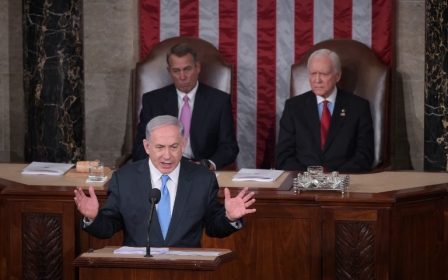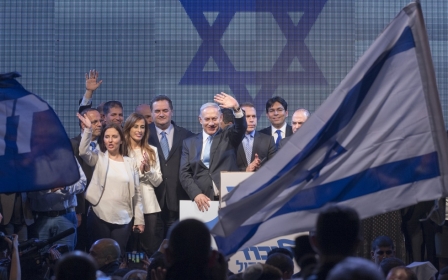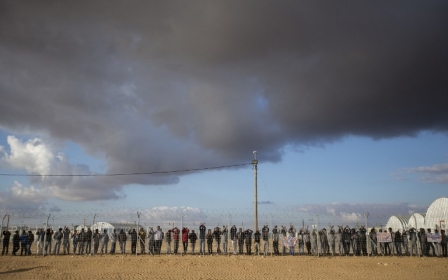Underneath electoral hype, Israel’s ethnic divide

As flagship events go, the anti-Netanyahu rally in Tel Aviv on Saturday night, meant to be a high point of the campaign to oust Israel's Prime Minister in next week’s general elections, left a lot to be desired. The turnout was unimpressive, the speakers uncharismatic, and the mood, attendees reported after the event, surprisingly lethargic.
The reason Israelis are still talking about the rally days later is not because of a passionate speech delivered by the former chief of Israel's Mossad spy agency, Meir Dagan, but rather because of a highly embarrassing - and potentially, electorally damaging - speech by an artist and frequent Haaretz contributor, Yair Garboz.
Garboz opened the rally by describing how he viewed Israel with Netanyahu at the helm, indulging in a popular habit of attributing the most extreme aberrations and abuses of powers to a tiny, unrepresentative minority.
“They told us that the man who killed the [former] prime minister [Rabin] was part of a delusional, tiny handful of individuals,” he said. “They told us he was under the influence of rabbis detached from reality, part of the crazy margins. They said those of yellow shirts with black badges, who shout “death to Arabs”, are a tiny handful. They told us the thieves and the bribe takers are only a handful. That the corrupt are no more than a handful…. the talismans-kissers, the idol-worshippers and those bowing and prostrating themselves on the tombs of saints - only a handful… then how is that this handful rules over us? How did this handful quietly become a majority?”
In the heated discussion that ensued, Garboz insisted he wasn’t referring to anyone of any particular ethnic origin. But to most Israelis, the phrase about "talisman-kissers" and "tomb worshippers" was as much dogwhistle politics as American lawyer Rudy Giuliani’s remarks a few weeks earlier about Obama “not being brought up like we were” was to black Americans. Some Ashkenazi Jews do all of the above too, usually in connection to the tomb of the 19th century Rabbi Nachman of Breslaw in Uman, Ukraine. But talismans and pilgrimages are a well-known staple in the lives of Jews from Middle Eastern and North African countries – also known as Mizrachim.
Although many Israelis - usually Ashkenazi European Jews, descendants of the founding elites of the state - like to portray Israel as a “melting pot”, the story of Mizrahi Jews in Israel is one of fierce and relentless discrimination. When they arrived, usually as refugees driven from Arab countries by the far ripples of the War of 1948, the Labor Zionist governments of the time ensured Mizrahis were housed in camps and far-flung frontier settlements, denied jobs and robbed of their tremendous cultural heritage. They were even violently shamed out of speaking their native Arabic. The bubbling indignation and discontent at this treatment found its outlet over 20 years later, when Mizrahi voters ousted a Labor government to replace it, for the first time, with the liberal-Zionist Likud.
The Likud liberal-capitalist approach opened a path for many Mizrahis through the hitherto tightly controlled nepotist economy set up by the Labor Zionists. The same Labor Zionist today tend to frown on any mention of the Ashkenazi-Mizrahi divide, insisting it is a thing of the past and bringing it up today is divisive and inappropriate.
But the Likud emphasised individual opportunity rather than collective rights, and this being the case, never bothered with affirmative action or far-reaching systemic reforms; it made it easier for ambitious individuals to overcome discrimination, but did not do nearly enough to prevent future discrimination.
To this day, a Mizrahi child is much more likely than an Ashkenazi one to be sent to a “vocational” school, which condemns him to a career of skilled menial labor. Despite tremendous advances in recent years - no thanks to any left wing party - Mizrahis are still badly under-represented in professional jobs and academia.
Garboz’s remarks were not merely patronising and prejudiced, throwing such innocuous - and to many, cherished - experiences as pilgrimage into the same category as corruption, genocidal racism and murder. They also highlighted a tremendously important and painful political divide that usually goes unseen by foreign observers: Israeli voters attribute considerable importance to the often unstated ethnic affiliation of a party, almost as much as they do to its political role.
A week before the rally, this overwhelmingly ignored reality was confirmed by a rare survey broadcast by Channel 10 that asked for whom Ashkenazis and Mizrahis intended to vote. The resulting division could not be clearer: 51 percent of the potential voters who support the Zionist Union, which the current standard bearer of Labor Zionism, are Ashkenazi, and only 29 percent are Mizrahi.
Among the voters for the Union’s more liberal cousin, Meretz, whose stronghold is among Tel Aviv academics, kibbutzim and professionals, 69 percent are Ashkenazi and 12 percent are Mizrahi. Habayit Hayehudi, product of the historic Ashkenazi Religious Zionist movement, has 46 percent Ashkenazi voters and 31 percent Mizrahi. Yesh Atid, an “apolitical” centrist capitalist party appealing to Israel’s urban young professionals, has 51 percent Ashkenazi voters and 29 percent Mizarhi.
Meanwhile, Likud, the original vehicle of Mizrahi electoral awakening, boasts the most equal division between the two communities, with 41 percent Ashkenazi voters and 39 percent Mizrahi. Kulanu, a centrist party led by a prominent Mizrahi, ex-Likud politician Moshe Kahlon, comes close to the Likud balance with 36 percent Ashkenazi voters and 42 percent Mizrahi. Shas, the only party so far to bill itself as a party by Mizrahis for Mizrahis, specifically, ultra-Orthodox Sephardi Jews, boasts 75 percent Mizrahis among its voters and only 5 percent Ashkenazi.
These results are further borne out by the voting data from the 2013 elections, processed into map form by the Madlan real estate portal. Hover over Tel Aviv, its northern suburbs or any of the kibbutzim that dot the map, and you will see overwhelming votes for Labor, Meretz and Yesh Atid. Look over Tel Aviv’s poorer southern suburbs, like Bat Yam and Rishon Letzion, or over the far-flung “development towns” where the original Mizrahi immigrants were shunted, and see the color change to blue, with overwhelming vote for right-wing parties and for Shas.
Israeli left-wingers who like to claim that intra-Jewish discrimination is a thing of the past also like to wonder loudly - and often sneeringly - why the poorest Israelis continue to vote for Netanyahu, even though his ultra-capitalist economic policies hurt them first. The question should rather be who and what they are voting against, and how the left-wing parties can address these grievances, past and present.
- Dimi Reider is an Israeli journalist, blogger and co-founder of +972 Magazine. His work has appeared in The New York Review of Books, The New York Times, The Guardian, Foreign Policy, Haaretz, Daily Beast, Al Jazeera and the Jerusalem Post. Dimi is also an Associate Policy Fellow at the European Council on Foreign Relations (ECFR).
The views expressed in this article belong to the author and do not necessarily reflect the editorial policy of Middle East Eye.
Photo: More than 40,000 Israelis gathered in Tel Aviv's Rabin Square on Saturday (MEE/Oren Ziv)
New MEE newsletter: Jerusalem Dispatch
Sign up to get the latest insights and analysis on Israel-Palestine, alongside Turkey Unpacked and other MEE newsletters
Middle East Eye delivers independent and unrivalled coverage and analysis of the Middle East, North Africa and beyond. To learn more about republishing this content and the associated fees, please fill out this form. More about MEE can be found here.





